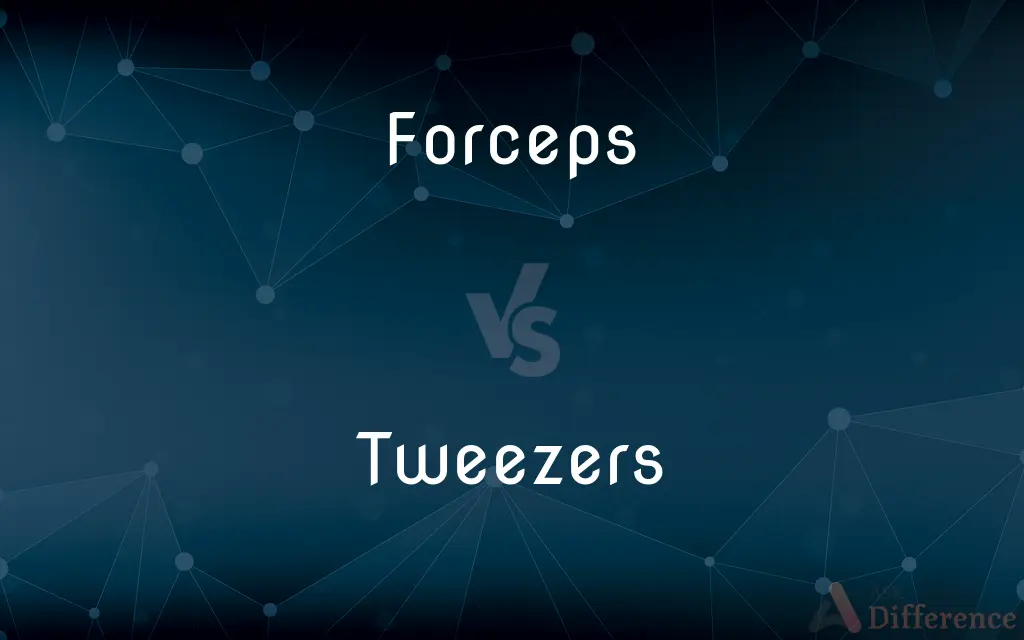Forceps vs. Tweezers — What's the Difference?
Edited by Tayyaba Rehman — By Fiza Rafique — Updated on November 6, 2023
Forceps are medical instruments for grasping; tweezers are smaller tools for picking up objects.

Difference Between Forceps and Tweezers
Table of Contents
ADVERTISEMENT
Key Differences
Forceps are typically used in medical procedures to grasp, hold firmly, or compress something, often tissue or surgical materials. They come in various forms, with designs specific to the task, whether in surgery or lab work. Tweezers, while similar in function, are generally used for more delicate or precise tasks such as plucking hair, handling small electronic components, or picking up tiny objects where fingers are too large.
In terms of construction, forceps are usually more robust and have a locking mechanism to hold items in place without continuous pressure from the user. They are often used in environments like operating rooms or delivery rooms. Tweezers, by contrast, are simple tools with two arms that come together at a pivot point and require constant pressure to hold an object; they are commonly found in personal grooming kits and laboratories.
Forceps, being medical instruments, are typically made of high-grade steel to withstand sterilization processes and repeated use in healthcare settings. They have various tip configurations, such as flat, cupped, or serrated, to match specific tasks. Tweezers are often made of steel but can also be found in plastic and are usually quite precise with pointed or slanted tips designed for accuracy rather than strength.
When considering the application, forceps can be used in delivering babies, performing biopsies, or removing foreign objects from the body. They need to be precise yet strong enough to manipulate body tissues. Tweezers are used for applications requiring fine motor skills, like in electronics to place or remove small parts, or in cosmetology for eyebrow shaping.
Lastly, the design of forceps often includes a ratchet mechanism to maintain grip without continuous pressure, while tweezers rely on the manual pressure applied by the user. Forceps are thus suited for prolonged procedures where constant grip is necessary; tweezers are better for quick, precise movements.
ADVERTISEMENT
Comparison Chart
Primary Use
Medical procedures
Picking up small objects
Size and Strength
Larger and stronger
Smaller and more delicate
Mechanism
May have locking mechanism
Operate on a pivot without locking
Material
High-grade steel for sterilizing
Steel, plastic, various metals
Precision
Varied, often less than tweezers
High precision, pointed tips
Compare with Definitions
Forceps
Handheld, hinged instrument for grabbing or extracting in medical applications.
The nurse handed the doctor forceps to use during the operation.
Tweezers
Hand tools with two arms that pinch together for precision work.
He used tweezers to extract the splinter from his finger.
Forceps
Pincers used in medical settings for manipulation, extraction, or compression.
During the procedure, the doctor used forceps to clamp the blood vessel.
Tweezers
Personal grooming tools commonly used to pluck hairs.
She tidied her eyebrows using a pair of sharp tweezers.
Forceps
Surgical instruments designed to hold tissue or objects during medical procedures.
The biopsy was performed using fine-tip forceps.
Tweezers
Small tools used for picking up objects too small to be easily handled with human fingers.
She used tweezers to place the delicate jewelry pieces.
Forceps
Tongs or pincers used in surgery or medical situations.
Obstetricians often use forceps during difficult childbirths to help deliver the baby.
Tweezers
Precision instruments for plucking or handling tiny objects.
The artist used tweezers to apply the tiny beads to her miniature sculpture.
Forceps
A tool used by medical professionals to grasp and hold onto objects.
The surgeon used forceps to remove the foreign object.
Tweezers
Tools with a spring mechanism for precise manual tasks.
Using tweezers, she placed the electronic components on the circuit board.
Forceps
Forceps (plural forceps or considered a plural noun without a singular, often a pair of forceps; the Latin plural forcipes is no longer recorded in most dictionaries) is a handheld, hinged instrument used for grasping and holding objects. Forceps are used when fingers are too large to grasp small objects or when many objects need to be held at one time while the hands are used to perform a task.
Tweezers
Tweezers are small tools used for picking up objects too small to be easily handled with the human fingers. The tool is most likely derived from tongs, pincers, or scissors-like pliers used to grab or hold hot objects since the dawn of recorded history.
Forceps
An instrument resembling a pair of pincers or tongs, used for grasping, manipulating, or extracting, especially such an instrument used by a surgeon.
Tweezers
A small pincerlike instrument, usually made of metal, used for handling or picking up small objects (such as postage stamps), plucking out (plucking) hairs, pulling out slivers, etc.
Forceps
A pincerlike pair of movable appendages at the posterior end of the abdomen in certain insects, such as earwigs.
Tweezers
Small pinchers used to pluck out hairs, and for other purposes.
Forceps
An instrument used in surgery or medical procedures for grasping and holding objects, similar to tongs or pincers.
Forceps
A pair of pinchers, or tongs; an instrument for grasping, holding firmly, or exerting traction upon, bodies which it would be inconvenient or impracticable to seize with the fingers, especially one for delicate operations, as those of watchmakers, surgeons, accoucheurs, dentists, etc.
Forceps
The caudal forceps-shaped appendage of earwigs and some other insects. See Earwig.
Forceps
An extractor consisting of a pair of pincers used in medical treatment (especially for the delivery of babies)
Common Curiosities
What are forceps mainly used for?
Forceps are mainly used for medical and surgical procedures.
Do tweezers have a locking mechanism?
Tweezers typically do not have a locking mechanism; they require manual pressure.
Can tweezers be used for medical purposes?
Yes, tweezers can be used in medical settings, but they are not designed for heavy-duty tasks like forceps.
What are tweezers primarily used for?
Tweezers are primarily used for picking up or handling small, delicate objects.
Do forceps have a locking mechanism?
Some forceps have a locking mechanism to maintain grip.
Are forceps only used in surgery?
No, forceps can also be used in various medical examinations and procedures.
Can forceps be used for precision work?
Forceps can be used for precision work, but they are generally larger and stronger than tweezers.
Do you need training to use forceps?
Yes, proper training is often required to use forceps, especially in medical settings.
Are tweezers used in electronics?
Yes, tweezers are commonly used in electronics for handling small components.
Can tweezers be used for grooming?
Yes, tweezers are often used for grooming, such as plucking hairs.
What material are tweezers made of?
Tweezers can be made of steel, plastic, or other materials, depending on their use.
How do you clean forceps?
Forceps are usually cleaned through autoclaving or with specific disinfectant solutions according to medical standards.
What material are forceps made of?
Forceps are usually made of high-grade steel suitable for sterilization.
Are forceps and tweezers sterilizable?
Forceps are typically sterilizable, while tweezers need to be made of a suitable material to withstand sterilization.
How do you clean tweezers?
Tweezers can be cleaned with alcohol or other disinfectants, depending on the material they're made from.
Share Your Discovery

Previous Comparison
Cottonseed vs. Cotton
Next Comparison
Sentry vs. SentinelAuthor Spotlight
Written by
Fiza RafiqueFiza Rafique is a skilled content writer at AskDifference.com, where she meticulously refines and enhances written pieces. Drawing from her vast editorial expertise, Fiza ensures clarity, accuracy, and precision in every article. Passionate about language, she continually seeks to elevate the quality of content for readers worldwide.
Edited by
Tayyaba RehmanTayyaba Rehman is a distinguished writer, currently serving as a primary contributor to askdifference.com. As a researcher in semantics and etymology, Tayyaba's passion for the complexity of languages and their distinctions has found a perfect home on the platform. Tayyaba delves into the intricacies of language, distinguishing between commonly confused words and phrases, thereby providing clarity for readers worldwide.













































